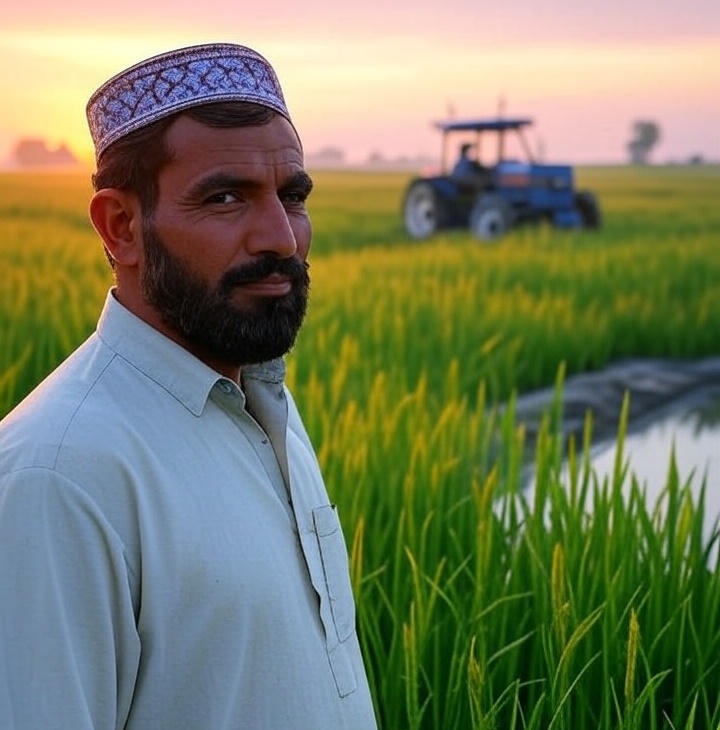Agriculture in Pakistan is more than just an occupation—it’s the lifeline of the rural population and a key pillar of our economy. With over 38% of the workforce engaged in farming and livestock, this sector contributes nearly 20% to the national GDP. But what makes Pakistan’s agriculture unique today is its transformation from traditional methods to smart, sustainable practices.
The Rich Agricultural Landscape of Pakistan
The Rich Agricultural Landscape of Pakistan
Pakistan is blessed with fertile plains and a rich agri-climate that supports a diverse range of crops. According to the Pakistan Bureau of Statistics, agriculture contributes around 19.8% to the national GDP and employs over one-third of the labor force—a testament to its socioeconomic importance.
Major Crops Grown in Pakistan
- Wheat – Cultivated in Rabi season; Pakistan ranks among the top ten global producers.
- Rice – A major export crop; Basmati from Punjab is globally prized.
- Sugarcane – Integral to the beverage and sweetener industry.
- Maize (Corn) – Used for both food and industrial purposes.
- Cotton – Once a major export crop, now facing climate and pest challenges.
📌 See our full guide on Wheat in Pakistan: Agronomy to Market
Beyond Crops: Livestock and Dairy Power
Agriculture in Pakistan isn’t just about crops. Livestock farming accounts for 60% of agricultural GDP. With nearly 200 million animals (cattle, buffalo, goats, sheep), Pakistan is one of the world’s top milk-producing countries. Yet, most dairy farms still operate below potential due to poor breed management and lack of veterinary access.
Dairy Development Opportunities:
- Artificial insemination and breed improvement
- Cold storage and transport chains
- Farmer training in feed management
From Challenges to Opportunities
Despite its potential, agriculture in Pakistan is riddled with real-world challenges—but these also present opportunities for innovation and reform.
1. Water Scarcity
💧 With agriculture using 90% of Pakistan’s freshwater, outdated irrigation practices cause massive wastage.
Solution: Shift to drip irrigation, laser land leveling, and farmer water-user associations.
2. Soil Fertility Decline
⚠️ Excessive use of DAP and urea has created imbalances in soil micronutrients.
https://agriculturepakistan.com/fertilizer-maize/Solution: Promote soil testing, organic composting, and balanced fertilization schedules.
🔗 See Fertilizer Schedule for Maize in Pakistan
3. Outdated Market Access
🚜 Farmers still sell through middlemen, earning only 30-40% of retail value.
Solution: Digital mandi platforms, farmer cooperatives, and direct-to-consumer models.
The Role of Modern Technology in Farming
Pakistan’s agri-sector is entering a tech-driven era. The fusion of mobile apps, remote sensing, IoT, and satellite imagery is redefining farm management.
Emerging Technologies:
- Agri Drones for crop spraying and pest detection
- Climate-Smart Apps like Pak Agri Market
- AI Weather Forecasting for better crop planning
- Agri-fintech Tools for microcredit access and insurance
Women in Agriculture: The Unseen Workforce
While often overlooked, women perform 60-70% of post-harvest work in rural areas. Yet they face restricted access to training, credit, and land ownership.
Empowering women through agri-trainings, microloans, and legal reforms could double agricultural productivity.
Government and Private Sector: A Shared Responsibility
Agricultural development needs both public infrastructure and private investment. The government’s role in subsidy reform, export policy, and infrastructure (like silos, roads, and cold chains) is critical.
Key Reforms to Watch in 2025:
- Revamp of the Seed Certification System
- Crop Insurance Schemes expansion
- Export facilitation under Pakistan Horticulture Vision
Roadmap for the Future: What Pakistan Needs to Do
✅ Encourage youth in agri-entrepreneurship
✅ Launch nationwide soil health cards
✅ Build farmer-led extension services
✅ Develop regional agri-export hubs
✅ Promote climate-resilient crop varieties
If these changes are implemented, agriculture in Pakistan can feed its people, empower its farmers, and boost global trade competitiveness.
Final Thoughts
Pakistan’s agricultural journey is at a crossroads—stuck between tradition and transformation. But with innovation, policy support, and farmer empowerment, we can redefine this sector for generations to come.
📩 Stay updated with weekly market rates and agri-news. Subscribe to our newsletter now!
